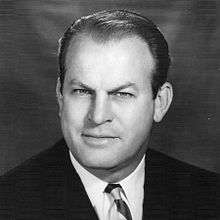John H. Shaffer
| John H. Shaffer | |
|---|---|
 | |
| United States Federal Aviation Administrator | |
|
In office March 24, 1969 – March 14, 1973 | |
| Preceded by | William F. McKee |
| Succeeded by | Alexander Butterfield |
| Personal details | |
| Born |
John Hixon Shaffer February 25, 1919 Everett, Pennsylvania |
| Died |
September 14, 1997 (aged 78) Frederick, Maryland |
| Spouse(s) | Joan Van Week (m. 1943) |
| Alma mater |
United States Military Academy (1943) Air Force Institute of Technology (1945) Columbia University |
John Hixon Shaffer (February 25, 1919 – September 14, 1997) was an administrator of the Federal Aviation Administration from March 24, 1969 until March 14, 1973.[1]
Most notably, he was the administrator during an en-masse calling-in sick strike of air traffic controllers during 1969. In the summer of that year, Shaffer himself testified in front of a congressional committee, reporting that air traffic controllers were neither overworked nor underpaid.[2] Shaffer's testimony, coupled with increased pressure on individual controllers to return to their jobs, Francis Lee Bailey of the Professional Air Traffic Controllers Organization stated "This guy Shaffer has got to go."[3] The FAA and Shaffer were both later attacked by the PATCO for continuing to operate despite the low number of air traffic controllers.[3]
On December 3, 1970, he testified to Conngress about aviation safety.[4]
Following his retirement from his position in the FAA, Shaffer was involved in the ongoing debate over both the inclusion of Microwave landing systems in civil aviation during 1978 and to whom the contract for construction of such devices should be awarded, American, British or German companies. Shaffer himself agreed with British assessments that the American manufactured MLS system was inferior and poorly tested.[5]
Awards
Notes
- ↑ http://books.google.ca/books?id=qOCghKQWAVMC&q=%22John+H.+Shaffer%22+AND+%22born%22&dq=%22John+H.+Shaffer%22+AND+%22born%22&hl=en&ei=mcE1TvCjI-ansALm76ncCg&sa=X&oi=book_result&ct=result&resnum=1&ved=0CC0Q6AEwAA
- ↑ Unfriendly skies - The air traffic controllers' sick-out, 1969 retrieved on April 27, 2007
- 1 2 Time Magazine One Man's Slow-Motion Aerial Act retrieved on April 27, 2007
- ↑ http://testimony.ost.dot.gov/test/pasttest/70test/Shaffer1.PDF
- ↑ Time Magazine A New MLS, But Whose? retrieved on April 27, 2007
- ↑ http://www.aeroclub.org/awards/wright.htm
| Government offices | ||
|---|---|---|
| Preceded by William F. McKee |
Federal Aviation Administrator 1969–1973 |
Succeeded by Alexander Butterfield |